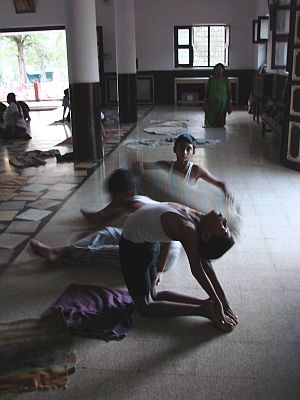This word ‘Ashtanga Vinyasa’ yoga is in Mysore like a mantra whispered by foreigners. They are here in Mysore the birthplace of the modern yoga to study the very ‘in’ yoga with it’s teacher Sri K. Pattabhi Jois.
We too good drawn in the hype to study yoga once we are here. Luckily to our tight budget and laziness to leave town we wanted to look for alternatives to Mr. Jois. With a lot of luck and help we found what we were looking for.
As a German I wanted exactly to know what I was studying and kept constantly asking my teachers for the name of the school the name of their teachers and the name of the yoga style. To my surprise they were calling there kind of yoga ‘Ashtanga yoga’ too. How can that be? How many Ashtanga styles exist? Is the name ‘Vinyasa’ the indication for the style or is there at the end only one?
So I started a 4 days hunt on the Internet to find out more. And at the end I think I know a little bit of something but I still don’t understand the hype on Sri K. Pattabhi Jois yoga school.
There are 4 main forms of yoga:
- Karma Yoga – Selfless service, i.e. working for others, e.g. Mother Theresa
- Bhakti Yoga – Yoga through devotion; e.g. Gandhi, Mother Theresa
- Jnana Yoga – Knowledge or wisdom, e.g. some scientists could be termed ‘Jnana yogi’s’
- Raja Yoga – Royal path
Raja yoga or the royal path is described in the Sutras by Patanjali as Ashtaga yoga which means literally ‘eight-limbed yoga’. It is a holistic system which will eventually bring the serious yogi to enlightenment.
The eight-limbs are:
- Yama – with five abstinences, e.g. ahimsa – to not cause pain
- Niyama – with five observances, e.g. saucha – purity of thought, word and deed
- Asana – seated posture – usually translated as posture
- Pranayama – the practice of breath awareness
- Pratyahara – the practice of withdrawal of the senses
- Dharana – the practice of concentration
- Dhyana – effortless meditation
- Samadhi – enlightenment
Everything that based on the eight limbs is called Ashtanga yoga and the ultimate goal is spiritual development. The called Hatha yoga is generally understood as the yoga of (physical) action and is practised in most Western Yoga classes. The known physical action of yoga is the smallest part of yoga and is just a preparation for Pranayama and Dhyana etc.
When yoga postures are breath-synchronized movements it is called Vinyyasa. To describe a style, Vinyasa means that poses will flow from one to another in conjunction with the breath. Teaching of Ashtanga yoga can vary and one of this ways is Mr. Jois school. His Vinyasas are very powerful and give you every time you practice a feeling of a good jogging with sweat and exhaustion. Through his ‘Ashtanga Vinyasa’ yoga the yogi produces intense internal heat and immense sweat that detoxifies muscles and organs.
During my google search the Ashtanga Yoga Research center by Sri K. Pattabhi Jois pops up as link everywhere and it seemed to me that it is claiming to teach the one and only real Ashtanga yoga. The question I cannot answer is if this understanding is a misinterpretation by us foreigners or if Mr. Jois is raising the claim. Obviously the meaning of Ashtanga yoga seems not full understood most by the attending foreigners or wrongly taught by their teachers. Different courses visited by us in Mysore are a show off of ego and power which is more the opposite direction of what we should searching for.
At the end it is not important what are you practicing more what is your mindset of your practice. Anyway it all goes back to one person Mr.Sri Krishnamacharya the teacher of Pattabhi Jois. Beside Mr. Jois famous and important teachers are having the same root. Mr. B.K.S. Iyengard who’s books around yoga are standard works, Krishnamacharya son T.K.V. Desikachar or his other famous disciple Indra Devi who all played a huge role in popularizing yoga in the West.
Whether you practice the dynamic series of Pattabhi Jois, the refined alignments of B.K.S. Iyengar, the classical postures of Indra Devi, or the customized vinyasa of Viniyoga, your practice stems from one source: a five-foot, two-inch Brahmin born more than one hundred years ago in a small South Indian village.
Krishnamacharya’s Legacy, by Fernando Pagés Ruiz for yogajournal.com
Alex



2 comments
Comments feed for this article
January 30, 2007 at 8:12 pm
Scott Hughes
Very informative article…
I love Yoga, but I don’t know that much facts and history about it. I’m always glad to read an informative article like the one above.
Thanks,
Scott Hughes
Yoga Forums
February 2, 2007 at 6:48 pm
Lesley
I agree. Excellent writeup on ashtanga yoga. Although I am not a big fan of ashtanga yoga, its benefits are undeniable.